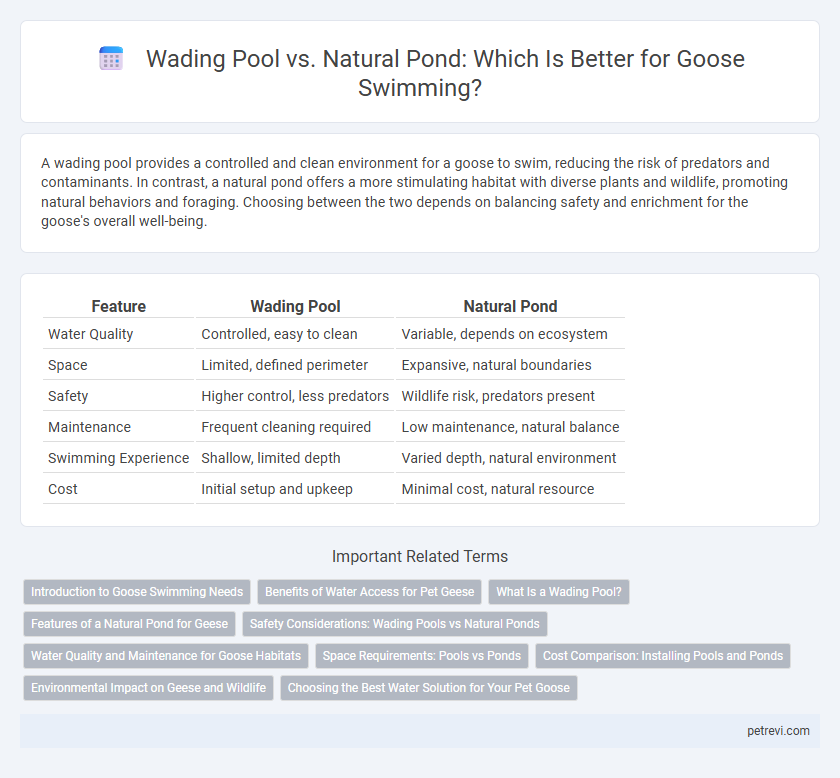A wading pool provides a controlled and clean environment for a goose to swim, reducing the risk of predators and contaminants. In contrast, a natural pond offers a more stimulating habitat with diverse plants and wildlife, promoting natural behaviors and foraging. Choosing between the two depends on balancing safety and enrichment for the goose's overall well-being.
Table of Comparison
| Feature | Wading Pool | Natural Pond |
|---|---|---|
| Water Quality | Controlled, easy to clean | Variable, depends on ecosystem |
| Space | Limited, defined perimeter | Expansive, natural boundaries |
| Safety | Higher control, less predators | Wildlife risk, predators present |
| Maintenance | Frequent cleaning required | Low maintenance, natural balance |
| Swimming Experience | Shallow, limited depth | Varied depth, natural environment |
| Cost | Initial setup and upkeep | Minimal cost, natural resource |
Introduction to Goose Swimming Needs
Goose swimming needs prioritize shallow, calm waters that allow easy entry and exit, making wading pools ideal for controlled environments. Natural ponds provide diverse ecosystems with ample space and natural vegetation, supporting natural behaviors like foraging and preening. Both options must ensure clean, fresh water to prevent diseases and support overall health in geese.
Benefits of Water Access for Pet Geese
Wading pools provide controlled, clean water environments that reduce exposure to parasites and harmful bacteria, supporting the health of pet geese. Natural ponds offer a more stimulating habitat with diverse aquatic plants and insects, promoting natural foraging behaviors and physical exercise. Access to water enhances feather maintenance, temperature regulation, and overall well-being in domestic geese.
What Is a Wading Pool?
A wading pool is a shallow, man-made water container designed specifically for geese to swim and bathe safely, providing easy access and controlled hygiene compared to a natural pond. Unlike natural ponds, wading pools offer predictable water quality and depth, reducing the risk of predators and waterborne diseases. Constructed from durable materials like plastic or concrete, wading pools require regular cleaning to maintain an optimal environment for goose health and comfort.
Features of a Natural Pond for Geese
A natural pond for geese offers a diverse ecosystem with aquatic plants and insects, promoting healthier swimming and foraging opportunities. Its varying depths provide safe resting areas and space for natural behaviors like diving and preening. The presence of natural vegetation and mud banks also supports better foot health and nesting sites compared to artificial wading pools.
Safety Considerations: Wading Pools vs Natural Ponds
Wading pools offer a controlled environment with shallow water, minimizing the risk of drowning and exposure to predators, making them safer for geese, especially young or weak individuals. Natural ponds provide a more complex ecosystem that can harbor parasites, toxins, and uneven depths, posing potential health and safety hazards. Regular monitoring and maintenance are essential for both water sources to ensure the geese's safety and well-being.
Water Quality and Maintenance for Goose Habitats
Wading pools offer controlled water quality with regular cleaning and filtration systems, reducing the risk of contaminants and parasites harmful to geese. Natural ponds provide a more diverse ecosystem but require consistent monitoring to prevent algae overgrowth, bacterial buildup, and pollution that can impact goose health. Maintaining water clarity and balance in both environments is crucial for supporting safe swimming habitats and promoting geese welfare.
Space Requirements: Pools vs Ponds
Wading pools for geese typically require less space, making them suitable for small backyards or urban settings, whereas natural ponds demand extensive land area to support proper ecosystem balance and water quality. Ponds offer more natural foraging opportunities and deeper waters for swimming, but their size and maintenance needs can be prohibitive for limited spaces. Choosing between these options depends on available land, with pools being space-efficient and ponds accommodating extensive natural behaviors.
Cost Comparison: Installing Pools and Ponds
Wading pools for geese typically involve lower installation costs, using affordable materials like plastic or concrete and requiring minimal landscaping. Natural ponds demand higher initial investments due to excavation, waterproofing, and ongoing maintenance for water quality and vegetation control. Choosing between the two depends on budget constraints and long-term upkeep considerations for optimal goose swimming environments.
Environmental Impact on Geese and Wildlife
Wading pools offer controlled environments that minimize disruption to local ecosystems, reducing the risk of water contamination and invasive species affecting geese health. Natural ponds provide more biodiversity benefits but may expose geese to parasites and predators, impacting their wellbeing. Balancing environmental impact involves assessing water quality management and habitat preservation to support both geese and surrounding wildlife.
Choosing the Best Water Solution for Your Pet Goose
Wading pools provide controlled, clean water ideal for daily goose swimming while minimizing the risk of parasites and predators. Natural ponds offer a more stimulating habitat with natural vegetation and diverse aquatic life, promoting healthier, instinctive behaviors. Evaluate your space, maintenance capability, and safety needs when choosing between a wading pool and natural pond for optimal goose well-being.
Wading pool vs Natural pond for Goose swimming Infographic

 petrevi.com
petrevi.com